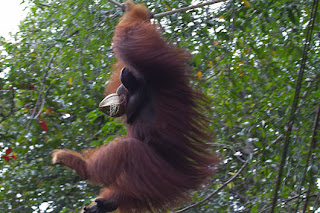 Sometimes when you travel, if you're lucky enough, there are moments that are extraordinary… connecting with someone from a culture vastly different from your own, seeing an endangered animal up close for the first time in the wild, or simply watching the sun set in a brilliant blaze of yellow and red. It's rare that one day can hold so many special moments but it happened for us aboard Orion II on Sunday.
Sometimes when you travel, if you're lucky enough, there are moments that are extraordinary… connecting with someone from a culture vastly different from your own, seeing an endangered animal up close for the first time in the wild, or simply watching the sun set in a brilliant blaze of yellow and red. It's rare that one day can hold so many special moments but it happened for us aboard Orion II on Sunday.
Every passenger on this ship was looking forward to visiting Camp Leakey at Tanjung Puting National Park. Dr. Birute Galdikas, who's been onboard lecturing since embarkation in Bali, has fought for and protected Tanjung Puting for the last forty years as part of her effort to study wild orangutans and rehabilitated ex-captive red apes. She put a stop to illegal logging here and made sure the practice of poaching animals was shunned by locals.
This place is incredibly special and worth protecting. The park is home to orangutans, proboscis monkeys, macaques, gibbons, clouded leopard, wild Borneo pigs, porcupines, Sambar deer, sun bears, crocodiles, monitor lizards, pythons and an incredible number of bird species such as hornbills and kingfishers.
Our day here started early. Half of the ship visited Camp Leakey on Day 1 of our visit to Tanjung while the other half went there on Day 2. This kept numbers somewhat reasonable but it still meant a large group (about 50) visited the camp together each day.
We loaded onto several zodiacs at 6:30am and traveled along the Sekonyer River for two hours.
We stopped along the way within the national park to visit a feeding platform in the forest and saw almost a dozen orangutans, including a large adult male with cheek pads. It was a short, easy walk into the forest to the feeding station and we spent about 45 minutes there. The orangutans that come for the daily feedings are those ex-captive apes that were rehabilitated by Dr. Galdikas and her team and then released into the park. Some orangutans continue to return for the feedings and others disappear into the forest to fend for themselves for the rest of their lives.
It was amazing to stand so close to the orangutans, who didn't seem to mind that we were there. Today's meal was milk and the animals drank up with gusto!
Upon departing the feeding station, local boats called klotoks picked us up and took us upriver to Camp Leakey. The river passage was beautiful and we spotted dozens of proboscis monkeys and macaques along the way. Local guides and Orion expedition leaders were on each klotoks and took the time to point out the flora and fauna and explain more about Indonesian culture.
Orion II's chef packed lunches (two sandwiches, an apple and orange, guava juice, peanuts, cookies, and cake) for guests and we ate aboard the klotoks before going on a tour of Camp Leakey guided by Dr. Galdikas herself. This was an incredible opportunity to learn firsthand about orangutans and the plight of Borneo's ecosystem.
Here we walked along well-trodden paths and saw a gibbon, many orangutans, Borneo pigs, and macaques. The walk to the feeding platform was special since Princess, a longtime resident of Camp Leakey, and one of her offspring accompanied us down the path.
At the feeding station we saw many more orangutans enjoy a lunch of mangoes and play on the platform and in the trees above.
In addition to our group was a handful of Indonesia school children. It wasn't easy to communicate but it was clear both groups were enamored with these beautiful red apes.
By early evening we all loaded back into our klotoks and sailed back down the river. It was a magical evening… the sun set a brilliant red and was the perfect backdrop for photos of those large-nosed proboscis monkeys. As dusk approached, we spotted several owls and hornbills. When night fell around us, fireflies light up trees on both sides of the river… better than any Christmastime lighting spectacular!The day was very special and makes this itinerary a must-do. In fact, if the cruise ended then and there, it would have still been worth the price of admission! Luckily though, this was just the beginning. Stay tuned for my next post, which will discuss our time at the Orangutan Care Center and Quarantine in the village of Pasir Panjang, near the town of Pangkalan Bun in Central Kalimantan.
Photos © Leonard Hospidor.

























































